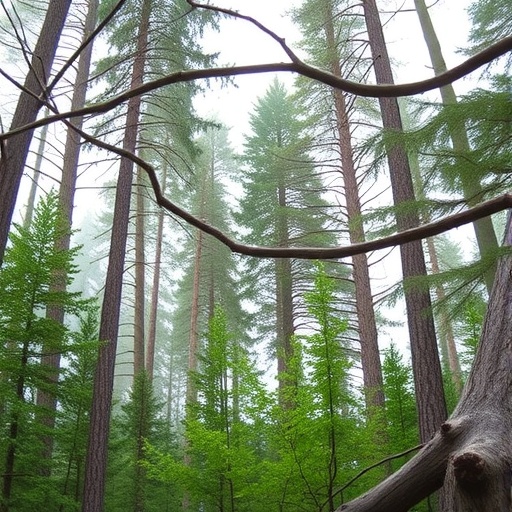In the face of accelerating environmental changes globally, the intricate dynamics of boreal forest ecosystems are coming under intense scrutiny. A groundbreaking study recently published in Nature Communications by Chen et al. delves into how shifting environmental conditions fundamentally reshape the diversity and dominance of understory plant communities in these vast northern forests. This research sheds crucial light on the subtleties of ecosystem responses beneath the towering canopy, offering unprecedented insight into plant ecological dynamics that have broad implications for biodiversity conservation and forest management amid climate change.
Boreal forests, spanning the circumpolar regions of the Northern Hemisphere, represent one of Earth’s largest terrestrial biomes. They serve as vital carbon sinks and biodiversity reservoirs, playing a pivotal role in global climate regulation. However, these ecosystems are susceptible to a suite of environmental stressors, including warming temperatures, altered precipitation regimes, and changing fire frequencies. While much attention has focused on the composition and health of overstory trees, this study pivots to the often-overlooked understory layer, where herbaceous plants and small shrubs form complex communities essential to overall forest function.
Using extensive field data collected across boreal forest sites with varying degrees of environmental change, the researchers employed advanced statistical models to analyze patterns of understory plant diversity and shifts in dominance hierarchies. By integrating long-term environmental monitoring with species-level trait analyses, the team uncovered nuanced relationships between environmental gradients and understory plant assemblages. The results point to a reshuffling of species dominance patterns, with consequences for forest resilience and nutrient cycling processes.
One of the key findings highlights that increased temperatures and changing soil moisture levels are driving reductions in species richness among understory plants. The warming boreal environment appears to favor more drought-tolerant species while disadvantaging those adapted to cooler, moist conditions. This selective pressure leads to a homogenization of the understory flora, potentially reducing functional redundancy and ecosystem stability. Such a loss in diversity poses risks that cascade through trophic levels, affecting pollinators, herbivores, and microbial communities.
Additionally, the study reveals changes in biomass allocation within understory communities. Certain shrub species exhibit pronounced dominance, growing more aggressively under altered environmental scenarios. This shift in dominance not only modifies vertical forest structure but also impacts light penetration, potentially influencing seedling recruitment and the growth patterns of young trees. The interplay between understory dominance and forest regeneration dynamics highlights a feedback loop critical to future boreal forest trajectories.
The researchers emphasize the complex interactions between multiple environmental drivers. For instance, the influence of warming temperatures on understory diversity is modulated by variations in soil nutrient availability and fire history. Disturbances such as fire can reset successional stages, temporarily boosting species richness before dominance patterns re-establish. This interplay indicates that management strategies in boreal forests must consider a mosaic of factors rather than singular environmental variables to predict and mitigate biodiversity loss effectively.
Methodologically, the study stands out by combining high-resolution remote sensing data with ground-based surveys. This approach allowed for spatially explicit analysis of understory vegetation patterns, capturing fine-scale heterogeneity shaped by microclimatic and edaphic conditions. The use of trait-based metrics provided mechanistic understanding of how functional attributes drive species’ responses to environmental shifts, pushing beyond mere species counts towards ecological process comprehension.
Importantly, the study situates its findings in the context of global climate change projections. As boreal regions warm at rates exceeding global averages, the documented trends in understory plant communities could intensify, restructuring forest ecosystems at fundamental levels. The authors call for vigilant monitoring of understory vegetation as an early indicator of ecosystem change, advocating for integrative approaches that combine ecological theory and applied conservation.
Beyond ecological implications, the results have significance for indigenous communities reliant on boreal forests for cultural and subsistence needs. Changes in understory composition affect availability of medicinal plants, food resources, and materials traditionally harvested. Therefore, understanding these shifts is integral not only to ecology but also to supporting resilience in human-forest interactions as environmental pressures mount.
The study also raises intriguing questions about evolutionary responses under rapid environmental change. The observed dominance shifts could signal selective advantages favoring certain species, potentially accelerating evolutionary trajectories. Investigating genetic diversity and adaptive capacity within dominant understory taxa represents a promising avenue for future research, offering hope for persistence despite environmental upheaval.
From a conservation perspective, this work underscores the necessity of protecting heterogeneous habitats within boreal forests that sustain diverse understory communities. Maintaining landscape connectivity and buffering against extreme disturbances could preserve functional diversity and forest ecosystem services. Adaptive management informed by ongoing research will be key to balancing exploitation and conservation goals in these ecologically critical regions.
In conclusion, the research by Chen et al. fundamentally enhances our understanding of how environmental change orchestrates complex shifts in boreal forest understory vegetation. By unveiling processes governing diversity loss and species dominance reshuffling, it provides a crucial framework for anticipating and mitigating the cascading effects of climate change. As boreal forests stand at a crossroads, such insights are invaluable to safeguarding their role in global ecological stability and human well-being.
Subject of Research: Environmental effects on understory plant diversity and dominance in boreal forests
Article Title: Environmental change shapes understory plant diversity and dominance in boreal forests
Article References:
Chen, X., Reich, P.B., Chen, X. et al. Environmental change shapes understory plant diversity and dominance in boreal forests. Nat Commun 16, 10579 (2025). https://doi.org/10.1038/s41467-025-65633-y
Image Credits: AI Generated
DOI: https://doi.org/10.1038/s41467-025-65633-y




